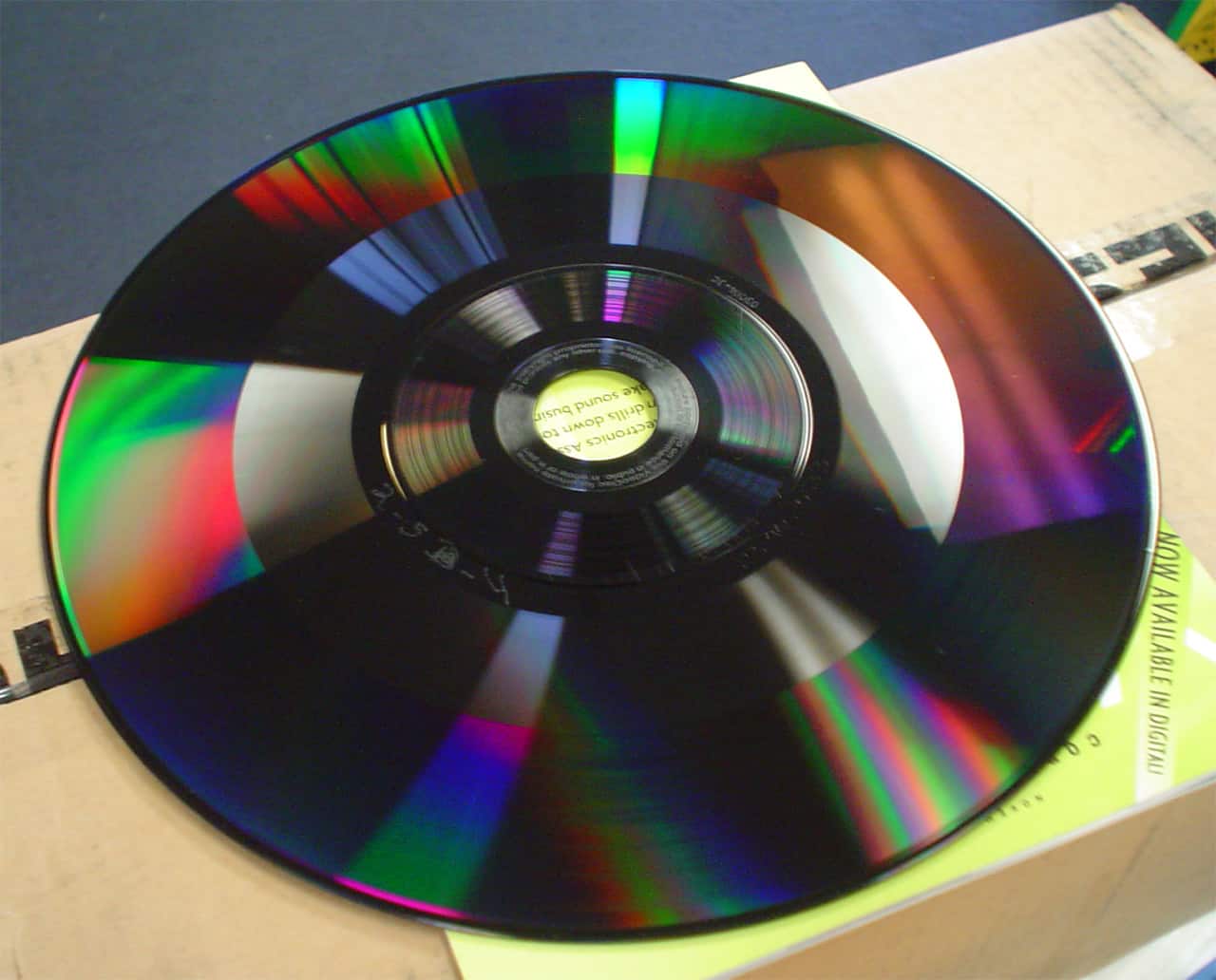It took quite a bit of trial and error and experimentation to get home video to where it is today. Long before the advent of 4K UHD discs, Blu-rays, DVDs, and streaming the home video industry saw some truly strange inventions, such as the CED.
In the first half of the 20th century, it was next to impossible to watch a movie at home. Your best bet was 8mm or 16mm film and a projector. Even then, the film reels could hold just enough for a comedy short or a cartoon. Magnetic tapes came about in the late 1950s and became popular in the late 1970s. CED failed to compete.
CED — or Capacitance Electronic Disc — was first conceived back in the mid-1960s, right as the magnetic tape industry was gearing up to go wide. However, the CED was far from ready for the public at this point in its rocky history. It would be close to 20 years before it actually hit shelves. And even then, CED lasted just three years before its eventual discontinuation.
What was CED, and what’s the reason why CED failed so spectacularly? Let’s take a look at the home video format’s history. Then, we’ll break down exactly why CED failed just a few years after its debut.
CED Specs
| Product Name | Capacitance Electronic Disc (CED) |
| Product Type | Analog video disc playback system |
| Also Known As | Videodisc, SelectaVision |
| Released | March 22nd, 1981 |
| Developer | RCA Corporation |
| Storage Capacity | 60 minutes of video per side (or 27,000 still frames per side) |
| Video Quality | 240p |
| Discontinued | April 4th, 1984 |
Why CED Mattered
While the short three-year lifespan might suggest an insignificant, unimportant product, the truth is that CED mattered quite a bit. As one of the first commercially viable home video formats, CEDs helped both consumers and feature film studios see the potential of watching movies at home.
Given the limitations of film reels — which, when projected at a movie theater, had to be changed multiple times in any given showing — there were few ways for the average moviegoer to bring the theatrical experience into the home. The advent of CED helped to make this a reality.
Beyond this, CED mattered for the way it offered a different kind of home video compared to the burgeoning magnetic tape format. Contrary to these systems, which relied on magnetic tape to store and display their contents, CEDs operated not unlike vinyl on a record player.

Using a special stylus coupled with a high-density system of grooves, CEDs were about a foot wide and were covered in spiraling grooves on both sides. The stylus and groove created an FM electrical signal, which was then interpreted by the CED player into video and audio signals.
This is what mattered most about CEDs; they took a huge swing at bringing feature films into the home, a concept that was long thought impossible. We really have it easy today in this regard. However, back in the mid-20th century, consumer electronics brands were trying anything and everything to make it a reality.
CED is just one of several failed attempts to do so — right alongside Betamax and LaserDisc. Still, the defunct analog video disc playback system matters tremendously for giving it a shot in the first place.
How Did People Feel About CED?
Unfortunately for the RCA Corporation, people felt far less enthusiastic about CED than the developer did. After pouring 17 years of research and development into the hopeful success of Capacitance Electronic Discs, the RCA Corporation was devastated to learn people just didn’t care enough to shell out the kind of money required to bring the theatrical experience into the home.
Praise
Still, those who did end up purchasing CED players — under 100,000 for the first year, and little more in 1983 and 1984 — had some praises to sing. For one, they were preferred by niche audiences over VHS, Betamax, and LaserDisc for their lower price. For the cost, CED image quality was on par with VHS and markedly worse than LaserDisc.
What’s more, CED enthusiasts defended the format for its lower maintenance costs and fewer moving parts to keep up with. (No tapes to rewind here.) On the production side, CEDs themselves were cheaper to make than any other format. They were simply stamped out and pressed like vinyl would be.
Obscurity
By the time CED was discontinued in April of 1984, RCA had only sold 550,000 CED players. In the end, by 1986, they had lost $650 million on unsold players and video discs. Left with nothing, RCA had to sell its brand to General Electric that same year.
The SelectaVision brand name was retired, and CEDs soon faded into collective obscurity. And yet, they have not been completely forgotten. Players are incredibly rare and highly coveted by nostalgic collectors today, giving them something of a second life in the modern day.
How CED Failed: A Complete History
Research into videodisc technology began at the RCA Corporation way back in 1964. The goal at this time was to bring a phonograph-esque playback method to home video. The research was done under the not-so-catchy name Discpix, which obviously did not stick.
Because the research and development team at RCA consisted of just four people and was spread out over multiple projects at once, work on the Discpix was slow-going. It wasn’t until 1972 that the Discpix team developed a working disc. This early prototype could hold just ten minutes of color video on either side.
At first, CED videodiscs were merely stored in jackets made to be placed in players by hand (much like you’d do with a vinyl record). However, early testing revealed a fatal flaw. Namely, handling CEDs by hand exposed the discs to more dust and grime, which in turn caused the videodisc’s grooves to skip.

If the particles were not immediately removed, they would cement themselves into the silicone lubricant in the grooves and cause a major malfunction. And so, with this discovery, RCA’s R&D team came up with the idea to utilize a plastic caddy for every disc.
This plastic caddy idea was exactly what CED needed in order to become commercially viable. In 1981, a whole 17 years after its original conception in the mid-1960s, the Capacitance Electronic Disc was finally ready to hit stores.
RCA was excited, to say the least. This far-off idea from the ’60s was now a reality in the ’80s, and the potential was tremendous. The company predicted 200,000 sales in the first year alone, with purchases exceeding this number in the years to follow. To say the least, sales of CED failed to even come close.
Early Signs of Imminent Failure
Perhaps it’s the benefit of hindsight always being 20/20, but the fact that CED would fail seems obvious when you look at the early signs. Of course, RCA didn’t see them. Honestly, they wouldn’t have seen them even if they were displayed in big, neon letters outside their headquarters.
After all, they seemingly did everything right. There were plenty of titles available for the CED playback system; over 50, in fact, spread out across all the major studios including Disney, MGM, Paramount, and Columbia.
So, it wasn’t an issue with title availability (a problem that plagued many other failed home video formats in the decades to come). It wasn’t an issue with price, either. The CED system was much more affordable than anything else out there on the market.
In fact, RCA went as far as to reduce prices even further when they missed the mark of 200,000 units sold by more than half. RCA even offered home video enthusiasts exclusive offers including mail-in rebates, free titles, and more. Alas, sales of CED systems continued to fall short.
In the end, perhaps the earliest sign of the CED’s eventual failure came in the research and development phase. Originally poised for a 1977 release, RCA had to delay the system by almost five additional years when they discovered a slew of catastrophic failures.
For one, these early discs could only store 30 minutes of video on each side. What’s more, the material used to manufacture the discs — a nickel-like substance — just wasn’t strong enough for mass production. CED prototypes would fall apart with even the lightest handling. Truthfully, CED failed before it even hit the shelves.
The Eventual Demise of CED
It took just three years of missed targets for RCA to concede. Over the course of the CED’s short three-year lifespan, it never even managed to hit the company’s initial first-year goal. With $650 million in losses overall, the fact that CED failed spectacularly was made all the worse by the sad truth that RCA never expected this fate.
Initially, RCA predicted their CED players would be in 50% of U.S. homes by 1985. Ultimately, though, CED failed before it even saw 1985. But then something crazy happened.
When the last remaining CED players in the RCA warehouse were liquidated to retailers for $20 a pop, demand for CED videodiscs went through the roof. Was there hope for the CED yet? RCA hoped so. At the last minute, they announced they’d continue to make videodiscs — even with the players themselves being discontinued as planned.
New titles kept showing up on CED for three whole years after the players ceased production. Alas, even this shot in the dark ended up missing the mark. RCA stopped videodisc production in 1986.

After losing more than half a billion dollars on the failed CED, the sale of RCA to General Electric was completed for $6.28 billion. GE broke the company up, selling partial ownership to BMG Music, MCI Communications Corporation, Westwood One radio network, and others. They kept RCA’s NBC Television Network for themselves. RCA was all but resigned from the home video industry, continuing to produce VCRs for the growing VHS market but opting not to try out any new consumer electronics for the time being.
Why CED Failed
There’s no denying the ingeniousness of the Capacitance Electronic Disc. Seeing as vinyl records continue to sell remarkably well in today’s market, it’s not outlandish to think that the CED might have stood a chance under different circumstances.
Unfortunately, it all boils down to this: RCA spent so long perfecting the videodisc, CED failed to stack up against the capabilities and specs of its closest competitors by the time it finally hit shelves. All the attention was on the showdown between Betamax and VHS. No one cared about the CED.
This doesn’t even begin to touch on what was going on with the higher-ups at RCA, either. It’s not like the struggle to get CED off the ground was the only problem at the company. Elsewhere, in an entirely different industry, RCA was losing just as much money on mainframe computer production.
Entered around the same time they began work on the CED in the mid-1960s, RCA hoped to go head-to-head with IBM — the world’s leading producer of mainframes. In reality, RCA’s Spectra 70 gave them under 5% of the market share.
It was going to cost RCA more than half a billion dollars in order to hold onto that market share. They withdrew from the mainframe market, writing these expenses off as a $500 million loss on their taxes that year. (Not unlike the write-off strategy Warner Bros. Discovery has been employing as of late.)
Couple this with the similar losses reported by the CED, and it was clear that RCA had some serious problems in the board room. At the end of the day, it’s fair to say that CED failed because RCA failed.
Why VHS Succeeded
While RCA researchers and developers tinkered away on the CED format in the lab, Betamax and VHS tapes were embroiled in a bloody battle. Betamax commanded a 100% market share in 1975, while VHS — which emerged in 1976 — had knocked the competitor’s hold down to less than 40% by 1980.
By the time CED hit stores in 1981, the home video market was already won over by VHS tapes. 60% of the market was loyal to the VHS tape. Given the cost of a new home video system and a sizable tape library, few were willing to switch loyalties to CED after shelling out so much on VHS.
With this in mind, it seems VHS succeeded simply because it came first. The massive success of the VHS was about so much more than this, however. Another huge appeal that hasn’t been mentioned yet? The VHS’s ability to record live television. You couldn’t do this with a CED.
Blank tapes inserted into a VCR allowed people to tape things straight off the TV. Plenty wanted a VCR to watch movies. Just as many were interested in one for the ability to record movies and TV shows themselves.
This two-in-one capability to both record and play tapes is inevitably what gave the VHS the biggest leg up in the home video format wars of the early-to-mid 1980s. Not only did it triumph over the CED, but it also trounced Betamax.
This kind of widespread and massive success in the home video market would not be seen again until the advent and popularity of the DVD as the 21st century neared. By 1987, CED failed for good, and the Betamax was on its way toward the same fate. Meanwhile, VHS dominated a whopping 90% of the market share.
The image featured at the top of this post is ©Athnex at English Wikipedia, Public domain, via Wikimedia Commons.

